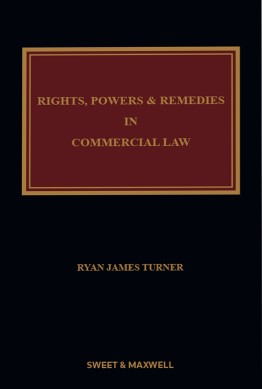Rights, Powers and Remedies in Commercial Law
ISBN13: 9780414080348
Published: June 2021
Publisher: Sweet & Maxwell Ltd
Country of Publication: UK
Format: Hardback
Special
Offer: £171.20
(Usual price £214.00)
This new work surveys the legal relations that are at play in the different disciplines of commercial law and the remedies that may be granted in connection with them. The book looks, in particular, at the way in which the law regulates some legal powers and not others and the entitlements of shareholders, creditors, and others to participate in collective decision-making processes that lead to the exercise (or not) of a contractual or statutory “majority” power.
The book distils doctrinal analysis into clear guidance and practical frameworks to assist commercial and commercial chancery practitioners and students to understand and advise on contracts and other instruments and disputes arising out of them. At the same time, the author draws out and seeks to resolve analytical fissures in the law, engaging in sustained analysis of important authorities such as the Supreme Court’s judgment in Braganza v BP Shipping Ltd [2015] 1 WLR 1661; Re Dee Valley Group plc [2018] Ch 55; Re Charterhouse Capital Ltd; Arbuthnott v Bonnyman [2015] EWCA Civ 536; and, Sunlink International holdings Ltd v Wong [2010] 5 HKLRD 653, among others.
The book includes the following further features, among others:
- Across seventeen core chapters, the book presents a descriptive argument about the way in which the law regulates legal powers (or does not) based on their distinctive features, so as to explain why the law controls some powers but not others and why the law does not control other legal relations such as voting rights.
- The book provides practical frameworks, in Chapters 3 to 5 and 8, for parties who are called on to exercise a power that has been granted to them under a contract or other instrument in order to assist them to exercise that power lawfully and in accordance with the terms in which the power is granted.
- The book suggests, in Chapter 7, standard terms and language that parties may seek to include in contracts and other instruments so as to bring about distinct consequences when powers are granted by contracts and other instruments.
- The book provides guidance, in Chapters 8 to 14, for parties who are participating in collective decision-making processes, such as shareholders voting in a general meeting and creditors voting on schemes of arrangement, restructuring plans, and voluntary arrangements.
- The book surveys, in Chapter 15, the way in which the terms of a contract or instrument may be used to modify or exclude the remedies that are available at an interim or final stage and the content of those remedies.
- The book provides practical guidance, in Chapter 17, for parties who seek interim remedies in the commercial sphere, with a particular focus on injunctions against shareholders to control or prevent the exercise of voting rights attaching to shares.
The book is principally concerned with the law of England and Wales, but it also draws on the laws of, in particular, Australia, Hong Kong, and the offshore territories in order to better explain and critique the law of England and Wales. The book is, therefore, likely to be helpful not only for practitioners in England and Wales, but for those practising in other common law jurisdictions where the law takes a similar form.
